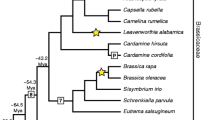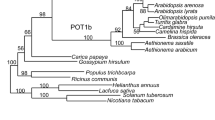Abstract
TheArabidopsis-type telomeric repeats (5′-TTTAGGG-3′) are highly conserved. In most families of different plant phyla they represent the basic sequence of telomeres that stabilize and protect the chromosome termini. The results presented here show that Alliaceae and some related liliaceous species have no tandemly repeated TTTAGGG sequences. Instead, their chromosomes reveal highly repetitive satellite and/or rDNA sequences at the very ends. These apparently substitute the original plant telomeric sequences in Alliaceae. Both sequence types are very active in homologous recombination and may contribute to the stabilization of chromosome termini via compensation of replication-mediated shortening.
Similar content being viewed by others
References
Barnes SR, James AM, Jamieson G (1985) The organisation, nucleotide sequence, and chromosomal distribution of a satellite DNA fromAllium cepa.Chromosoma 92: 185–192.
Biessmann H, Mason JM (1992) Genetics and molecular biology of telomeres.Adv Genet 30: 185–249.
Bougourd SM, Parker JS (1976) Nucleolar-organiser polymorphism in natural populations ofAllium schoenoprasum.Chromosoma 56: 301–307.
Feinberg AP, Vogelstein B (1983) A technique for radiolabeling DNA restriction endonuclease fragments to high specific activity.Anal Biochem 132: 6–13.
Fuchs J, Schubert I (1995) Localization of seed protein genes on metaphase chromosomes ofVicia faba via fluorescentin situ hybridization.Chrom Res 3: 94–100.
Fuchs J, Brandes A, Schubert I (1995) Telomere sequence localization and karyotype evolution in higher plants.Plant Syst Evol 196; 227–241.
Fussell CP (1975) The position of interphase chromosomes and late replicating DNA in centromere and telomere regions ofAllium cepa L.Chromosoma 50: 201–210.
Ijdo JW, Wells RA, Baldini A, Reeders ST (1991) Improved telomere detection using a telomere repeat probe (TTAGGG)n generated by PCR.Nucleic Acids Res 19: 4780.
Irifune K, Hirai K, Zheng J, Tanaka R, Morikawa H (1995) Nucleotide sequence of a highly repeated DNA sequence and its chromosomal localization inAllium fistulosum.Theor Appl Genet 90: 312–316.
Mason JM, Biessmann H (1995) The unusual telomeres ofDrosophila.Trends Genet 11: 58–62.
Okazaki S, Tsuchida K, Maekawa H, Ishikawa H, Fujiwara H (1993) Identification of a pentanucleotide telomeric sequence, (TTAGG)n, in the silkwormBombyx mori and in other insects.Mol Cell Biol 13: 1424–1432.
Pich U, Schubert I (1993a) Polymorphism of legumin genes in inbred lines ofVicia faba.Biol Zentbl 112: 342–350.
Pich U, Schubert I (1993b) Midiprep method for isolation of DNA from plants with a high content of polyphenolics.Nucleic Acids Res 21: 3328.
Pich U, Houben A Fuchs J, Schubert I (1994) Utility of DNA amplified by degenerate oligonucleotide-primed PCR (DOP-PCR) from the total genome and defined chromosomal regions of field bean.Mol Gen Genet 243: 173–177.
Pich U, Fritsch R, Schubert I (1996) Closely relatedAllium species share a very similar satellite sequence.Plant Syst Evol (in press).
Richards EJ, Ausubel FM (1988) Isolation of a higher eukaryotic telomere fromArabidopsis thaliana.Cell 53: 127–136.
Ricroch A, Peffley EB, Baker RJ (1992) Chromosomal location of rDNA inAllium: in situ hybridization using biotin-labelled and fluorescein-labelled probe.Theor Appl Genet 83 413–418.
Rovira C, Beermann W, Edström J-E (1993) A repetitive DNA sequence associated with the centromeres ofChironomus pallidivittatus.Nucleic Acids Res 21: 1775–1781.
Saiga H, Edström J-E (1985) Long tandem arrays of complex repeat units inChironomus telomeres.EMBO J,4: 799–804.
Sato S (1981) Cytological studies on the satellited chromosomes ofAllium cepa.Caryologia 34: 431–440.
Schubert I (1984) Mobile nucleolus organizing regions (NORs) inAllium (Liliaceae s. lat.)? — Inferences from the specificity of silver staining.Plant Syst Evol 144: 291–305.
Schubert I, Wobus U (1985)In situ hybridization confirms jumping nucleolus organizing regions inAllium.Chromosoma 92: 143–148.
Schubert I, Ohle H, Hanelt P (1983) Phylogenetic conclusions from Giemsa banding and NOR staining in top onions (Liliaceae).Plant Syst Evol 143: 245–256.
Yakura K, Tanifuji S (1983) Molecular cloning and restriction analysis ofEcoRI-fragments ofVicia faba rDNA.Plant Cell Physiol 24: 1327–1330.
Young BS, Pession A, Traverse KL, French C, Pardue ML (1983) Telomere regions inDrosophila share complex DNA sequences with pericentric heterochromatin.Cell 34: 85–94.
Zhang Y-J, Kamnert I, López CC, Cohn M, Edström J-E (1994) A family of complex tandem repeats in the telomeres ofChironomus pallidivittatus.Mol Cell Biol 14: 8028–8036.
Author information
Authors and Affiliations
Additional information
Accepted for publication by M. Schmid
Rights and permissions
About this article
Cite this article
Pich, U., Fuchs, J. & Schubert, I. How do Alliaceae stabilize their chromosome ends in the absence of TTTAGGG sequences?. Chromosome Res 4, 207–213 (1996). https://doi.org/10.1007/BF02254961
Received:
Revised:
Accepted:
Issue Date:
DOI: https://doi.org/10.1007/BF02254961




